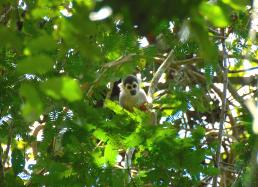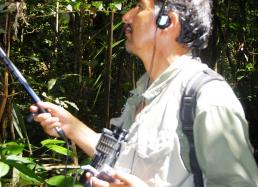6. Camp 2: A Day in an Ornithologist's Life - Part 2
In my last dispatch, I had just finished surveying the edge of the lake at Redondococha. It’s now 9:40 AM, and I decide that I can do a relatively short loop through the forest (four kilometers) and look for some forest birds before returning to camp.
It’s late, so there isn’t much singing, but there are always birds in the Amazonian forest. A nice Ringed Woodpecker and a big displaying Olive Oropendola are new for the trip. There are some monkeys—a group of about 20 squirrel monkeys (see above photo) is just outside of camp. Later, there’s a group of about ten Graell's Tamarin monkeys (Saguinus graellsii) and a small group of White-fronted Capuchins (Cebus albifrons) crashing about.
Finally at 11:13 AM, I find what I'm looking for: a mixed species flock, the first of four I'll eventually see today. It’s a good one, with both canopy and understory birds. I drop my pack on the trail and head off to follow it through the forest and see what’s in it. I spend a little over half an hour with the flock before returning to the trail about 20 meters away from my pack. Didn’t get lost, stung by wasps or ants, didn’t fall or trip; lots of mosquito bites, one good leg gouge from a broken-off limb, but I found 23 species in this flock. A big flock can have as many as 40 species, but there weren’t really many tanagers with this flock.
Most species in a flock are represented by a mated pair, or a pair with dependent young. The understory birds are mainly antbirds (big flycatching ones like the flock leaders, Cinereous and Dusky-throated Antshrikes) and the little antwrens, which I worked on for my dissertation. This flock has four species of antwrens: Gray, Long-winged, White-flanked and Rufous-tailed.
Other birds in the flock include a couple of species of greenlets (small vireos, if that helps), a loud pair of Fulvous Shrike-Tanagers, a pair of Ash-winged Antwrens in the canopy feeding a young bird, a couple of species of woodcreepers, a couple of species of flycatchers, a Purple Honeycreeper, a Rufous-rumped Foliage-gleaner, a Striped Woodhaunter, a Lafresnaye’s Piculet (a tiny woodpecker), a Plain Xenops, and scattered others, plus a prize—a nice male Canada Warbler.
Canada Warblers breed in the boreal forest of the eastern United States and winter in the forests on the lower slopes of the Andes. They’re migrating right now, so they can show up in unexpected places. But here, hundreds of kilometers east of the Andes, is a bit more than unexpected—especially in that this was just the first of six that I saw over the next two days! Five were in mixed species flocks, and one was by itself along the lake edge.
Actually, relatively few migrants from North America make it this far south. We’ve been seeing shorebirds—both yellowlegs, Solitary and Spotted Sandpipers—on the river trips and on the lake at our first camp, plus migratory swallows like Barn, Bank, and Cliff. But forest-based migrants are few. Patricio found an Eastern Wood Pewee this same day. It’s widespread in winter in South America. I had our first Red-eyed Vireo the previous day. I found a Swainson’s Thrush the following day. Like the warbler, it winters in the Andes, but it’s less unexpected out in the Amazonian lowlands.
There are really only a handful of other North American landbird migrants that come this far south in Peru in any numbers: Scarlet and Summer Tanagers, Alder and Olive-sided Flycatchers, two cuckoos, Gray-cheeked Thrushes, and Blackpoll Warblers come to mind. Most North American birds winter in Central America, where there are enough to be a significant part of the avifauna during the winter. Here, they exist around the edges for the most part, although Swainson’s Thrush is unbelievably common in the Andes in winter.
After dinner, Debby, Patricio, and I review the day’s list. Together, we’ve had 188 species for the day (see additional photos below). I had 143 myself. We added 25 species to the overall list, bringing the total to 320 species after five days in the field, and the camp list to 244, eleven more than at the first camp at the same time. All in all, a successful day. At about 7:30, I head to my tent to go to sleep and prepare to see what tomorrow will bring.
Doug
(To learn more about the birds that I and my colleagues spotted during the Rapid Inventory, check out our “Video Report 8: Birds.”)
Written October 11, 2007







